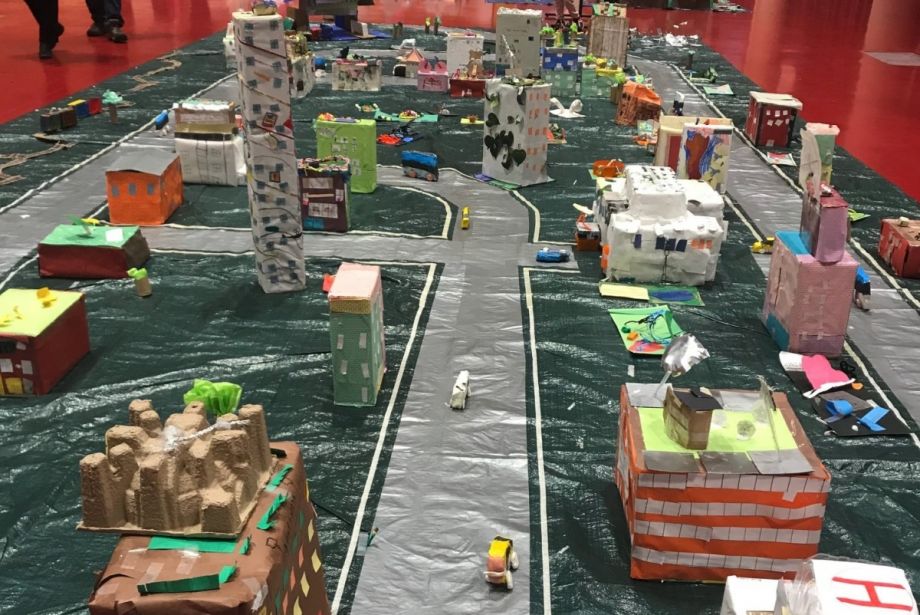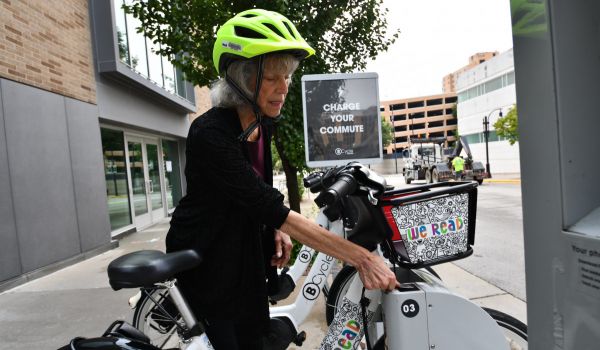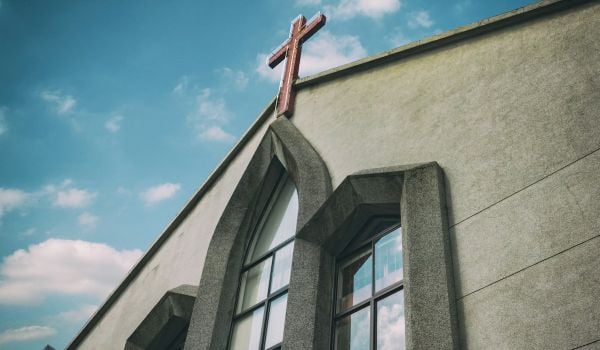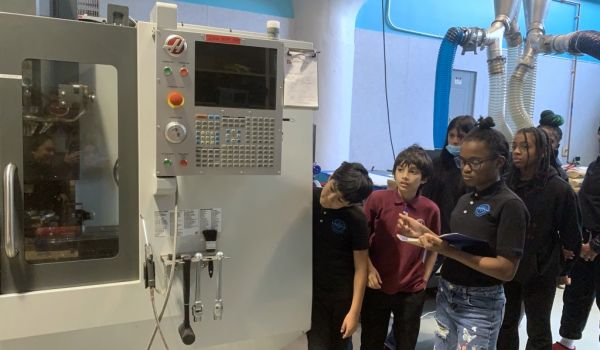Every other year, Jen Greenwald helps build a neighborhood with her class of second graders in Madison, Wis. It always raises some interesting questions about growing up in cities.
“There are these cool bus stops all over the world and places where you think about bringing strangers together in public spaces,” says Greenwald. “Our kids are so raised to think you don’t talk to strangers and strangers aren’t good, but we’re never going to have community if we don’t talk to each other.”
The neighborhood Greenwald’s students help build is part of the Terrace Town project, a 13-week urban planning project that culminates with the students building model neighborhoods that are displayed together at Monona Terrace, Madison’s convention center. This year’s project ended recently, with model neighborhoods built by students from across the city and county on display.
The materials for the project come from the students’ families’ recycling bins. One student used a plastic cherry tomato container to create a Green Bay Packer-themed bus stop.
The project helps students to think about spaces and how to “make them inviting and friendly to people,” Greenwald says.
Terrace Town follows the Box City curriculum developed by Ginny Graves in the 1970s. Graves founded the Center for Understanding the Built Environment. The organization says its tools have been used in 30 countries and in every major and many smaller cities across the US.
Nearly half of the children at Muir Elementary School, where Greenwald has been teaching for a decade, receive free or reduced lunch, even if the area closest to the school is a well-to-do white community. Madison is nearly 80 percent white, yet, in Greenwald’s class of 31 second graders, eight children speak different Indian languages, such as Marathi, Telugu, Gujarati and Tamil. There are also a couple of Spanish speakers.
Facilitating human interaction and community building is just one of the reflections Terrace Town stimulates. “Seeds are planted, like thinking about our impact on the planet,” Greenwald says. “I think they all probably understand the idea of a footprint, like the footprint of a building.”
As part of the project, students also visit the local sewage treatment plant and a landfill.
Heather Sabin coordinates the program for Monona Terrace. “What we see is that kids are really understanding that what exists are choices made by people,” she says. “And that when they walk out their door, it’s not that these things just happen, but that there are designers involved and planners and architects and that, even as a citizen, they can be involved in the evolution of their environment.”
Sabin says that the project is connected to learning objectives in the local school system. “We were able to connect with curriculum quite easily,” she says. “The whole idea wasn’t ‘let’s learn architecture.’ Or, ‘let’s learn city planning,’ but rather integrating that across math, science, literacy, etc.”
Terrace Town also also includes a visual literacy element, Sabin explains. “Is it a dense environment? Is it more suburban or rural? What are the types of buildings you’re seeing? Is this working for me as a kid? Is the transportation friendly to a kid?”
Various members of the Wisconsin chapter of the American Institute of Architects volunteer their time to support classrooms as they develop Terrace Town neighborhoods. Chapter member Tom Hirsch, who happens to be Greenwald’s stepfather, has mentored her class several times.
Hirsch agrees that giving children an opportunity to design and plan brings an important perspective. Every year, Hirsch likes to ask students, “What makes for a workable neighborhood?”
“We spent the better part of one session talking about urban design that is child friendly,” says Hirsch. Their answers, he says, reflect their realities, such as wanting to be able to reach a park without crossing a street. “A lot of it had to do with outdoor play areas,” says Hirsch. “A few of them mentioned outdoor sculptures, public art, big stuff, but mostly it was sports and play areas.”
But, Hirsch adds, the children also take very easily to energy management, energy conservation, alternative fuels and renewables. “That doesn’t take a whole bunch of convincing,” he says. “They incorporate that right away.”
The program also allows children to be creative. “Because it’s very unusual in terms of hands-on drawing and shapes and using rulers, etc., it really appeals to kids in a way that doing math drills in workbooks doesn’t,” Hirsch adds.
Says Greenwald: “They don’t have a lot of opportunities to design and build something in their regular classroom. I think that’s the part that they love and that’s the part they remember the most.”
EDITOR’S NOTE: This article originally mis-attributed a quote by Hirsch to Greenwald. We’ve corrected the error. We have also clarified that Terrace Town happens every other year.
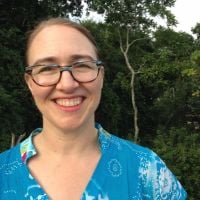
Zoe Sullivan is a multimedia journalist and visual artist with experience on the U.S. Gulf Coast, Argentina, Brazil, and Kenya. Her radio work has appeared on outlets such as BBC, Marketplace, Radio France International, Free Speech Radio News and DW. Her writing has appeared on outlets such as The Guardian, Al Jazeera America and The Crisis.
Follow Zoe .(JavaScript must be enabled to view this email address)

